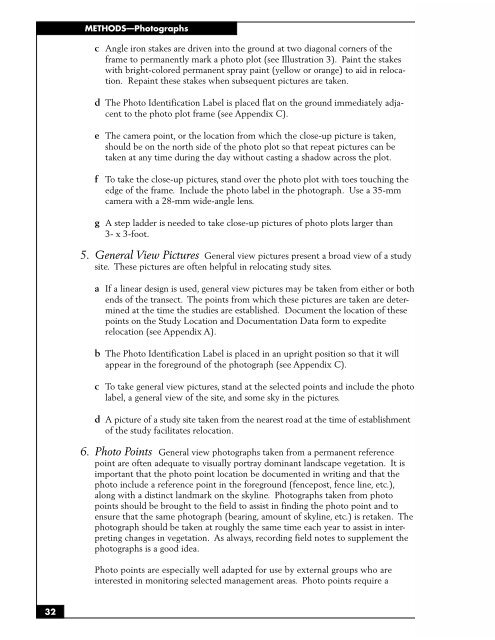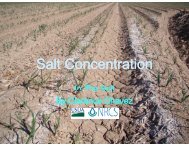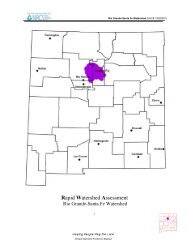SAMPLING VEGETATION ATTRIBUTES - New Mexico NRCS - US ...
SAMPLING VEGETATION ATTRIBUTES - New Mexico NRCS - US ...
SAMPLING VEGETATION ATTRIBUTES - New Mexico NRCS - US ...
You also want an ePaper? Increase the reach of your titles
YUMPU automatically turns print PDFs into web optimized ePapers that Google loves.
32<br />
METHODS—Photographs<br />
c Angle iron stakes are driven into the ground at two diagonal corners of the<br />
frame to permanently mark a photo plot (see Illustration 3). Paint the stakes<br />
with bright-colored permanent spray paint (yellow or orange) to aid in relocation.<br />
Repaint these stakes when subsequent pictures are taken.<br />
d The Photo Identification Label is placed flat on the ground immediately adjacent<br />
to the photo plot frame (see Appendix C).<br />
e The camera point, or the location from which the close-up picture is taken,<br />
should be on the north side of the photo plot so that repeat pictures can be<br />
taken at any time during the day without casting a shadow across the plot.<br />
f To take the close-up pictures, stand over the photo plot with toes touching the<br />
edge of the frame. Include the photo label in the photograph. Use a 35-mm<br />
camera with a 28-mm wide-angle lens.<br />
g A step ladder is needed to take close-up pictures of photo plots larger than<br />
3- x 3-foot.<br />
5. General View Pictures General view pictures present a broad view of a study<br />
site. These pictures are often helpful in relocating study sites.<br />
a If a linear design is used, general view pictures may be taken from either or both<br />
ends of the transect. The points from which these pictures are taken are determined<br />
at the time the studies are established. Document the location of these<br />
points on the Study Location and Documentation Data form to expedite<br />
relocation (see Appendix A).<br />
b The Photo Identification Label is placed in an upright position so that it will<br />
appear in the foreground of the photograph (see Appendix C).<br />
c To take general view pictures, stand at the selected points and include the photo<br />
label, a general view of the site, and some sky in the pictures.<br />
d A picture of a study site taken from the nearest road at the time of establishment<br />
of the study facilitates relocation.<br />
6. Photo Points General view photographs taken from a permanent reference<br />
point are often adequate to visually portray dominant landscape vegetation. It is<br />
important that the photo point location be documented in writing and that the<br />
photo include a reference point in the foreground (fencepost, fence line, etc.),<br />
along with a distinct landmark on the skyline. Photographs taken from photo<br />
points should be brought to the field to assist in finding the photo point and to<br />
ensure that the same photograph (bearing, amount of skyline, etc.) is retaken. The<br />
photograph should be taken at roughly the same time each year to assist in interpreting<br />
changes in vegetation. As always, recording field notes to supplement the<br />
photographs is a good idea.<br />
Photo points are especially well adapted for use by external groups who are<br />
interested in monitoring selected management areas. Photo points require a




